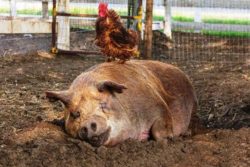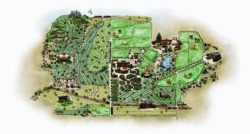Read Time: 6 Minutes Subscribe & Share
A Trip Down Apricot Lane
 We just watched with the Bolognese branch of the family, in dubbed Italian, The Biggest Little Farm – La Fattoria dei Nostri Sogni. I admit to having watched this documentary three or four times, so I can testify that the Italian voice of Molly was pretty much on pitch. This is not only a happy place film but also one that explores in an engrossing manner the struggles and financial aid required to rejuvenate a lifeless patch of earth into a beautiful and productive farm through strict adherance to some biodynamic principles of agriculture. Which brings me to perhaps the overlooked central character in this absorbing documentary. And, no, it is not Emma or the ill-fated Mr. Greasy, but rather Alan York, whose green thumbprints are all over the film.
We just watched with the Bolognese branch of the family, in dubbed Italian, The Biggest Little Farm – La Fattoria dei Nostri Sogni. I admit to having watched this documentary three or four times, so I can testify that the Italian voice of Molly was pretty much on pitch. This is not only a happy place film but also one that explores in an engrossing manner the struggles and financial aid required to rejuvenate a lifeless patch of earth into a beautiful and productive farm through strict adherance to some biodynamic principles of agriculture. Which brings me to perhaps the overlooked central character in this absorbing documentary. And, no, it is not Emma or the ill-fated Mr. Greasy, but rather Alan York, whose green thumbprints are all over the film.
Not A Household Name
Although the film gave Alan York some posthumous fame after he died in 2014, little biographical information about him is available. After apprenticing with British Master Gardener Alan Chadwick for three years, Alan pursued a career as a farming landscape designer and gardener, and you can clearly see these design skills in this film and other properties he consulted with. He is probably best noted for his work in convincing vintners to adopt and adhere to his pared down biodynamic principles. It takes years to biodynamically reclaim conventionally farmed acreage. From Benziger Vineyards in California to the Tuscan vineyard of Trudie Styler and Sting, Alan York’s four biodynamic principles are followed as closely as nature and human willingness will allow. Even he said that no one was perfect! Alan York’s four principles are as follows:
for three years, Alan pursued a career as a farming landscape designer and gardener, and you can clearly see these design skills in this film and other properties he consulted with. He is probably best noted for his work in convincing vintners to adopt and adhere to his pared down biodynamic principles. It takes years to biodynamically reclaim conventionally farmed acreage. From Benziger Vineyards in California to the Tuscan vineyard of Trudie Styler and Sting, Alan York’s four biodynamic principles are followed as closely as nature and human willingness will allow. Even he said that no one was perfect! Alan York’s four principles are as follows:
Try to create as closely as possible a closed system in relation to nutrients. An agricultural property has within its own sphere the ability to become a thriving ecosystem and productive farm if supplied with nutrients and addressed with treatments and procedures from biodynamic principles. Livestock is included as an “in house” supplier of nutrients, and a reusable source of water is created and maintained within the property.
Create a landscape ecology i.e. biodiversity within the property (as opposed to monoculture) The property owner must discover what plants, animals, (predator and prey alike) can thrive within this piece of land. This will include rotating cover crops and trees to attract birds and insects, which in turn will aid in the building of a unique ecosystem.
Follow the use of biodynamic preparations – 2 field sprays and 6 compost preparations (1 in the compost, and 5 outside the compost). Living organisms are what support growing plants and animals and all organisms have a life cycle. These biodynamic preparations vary according to whether they are designed for plants or animals and can be sourced through the property’s own ecoystem or in partnership with other biodynamic farmers. The international organization for biodynamic agriculture, Demeter, also lists sources for these preparations for biodynamic farmers who are unable to produce their own.
Work out over time a holistic system – a focus on the inner action of all living things within the ecosystem of the property The effort here is to maintain a healthy and balanced environment for the whole agricultural property – to keep all the organisms within the landscape robust and healthy but in balance.
In the film and in his writings, Alan’s mantra was always to treat these four principles equally – “Nothing is more important than anything else and nothing is optional.”
Biodynamics 101
It is difficult to unravel the interwoven philosophical and scientific threads of organic, regenerative organic, and biodynamic agriculture, but biodynamic advocates probably have a bit of other-worldliness mixed in with the science, which makes it somewhat of a stretch for strictly scientific agronomists. Biodynamics has had a surprising following among vintners as well as farmers in Europe but has been slow to gain ground in American vineyards and farms. According to Demeter, there were just 66 certified US biodynamic farms in 2019.
 The first constructs of Biodynamic farming were penned by Rudolf Steiner, an Austrian philosopher and social reformer with an astonishing number of interests and followers. He was deeply spiritual, somewhat in the same sense that early Greeks formed a religious belief in which Gaia was the mother earth – often pictured in a cornucopia – with all the benefits that our planet offers within her sphere.
The first constructs of Biodynamic farming were penned by Rudolf Steiner, an Austrian philosopher and social reformer with an astonishing number of interests and followers. He was deeply spiritual, somewhat in the same sense that early Greeks formed a religious belief in which Gaia was the mother earth – often pictured in a cornucopia – with all the benefits that our planet offers within her sphere.
NB for those of you who missed out on reading or being read to D’Aulaire’s Greek Myths, order a copy now through your favorite bookstore (we use Old Town Books and Hooray For Books) and enjoy it for yourself and younger inquiring minds.
Casting aside hesitations about burying manure in a cow’s horn over the winter (which actually proved to create an enriched elixir for soil) and accepting that many of the principles are based on philosophy rather than lab science, there is much to be learned from stripped down biodynamics. One should also remember that Steiner was writing to the Eastern European farmer and that 21st century biodynamic thinking recognizes that all agricultural properties and areas are different – like human beings.
Conventional farming is focused on the raising to fruition or slaughter a single plant or animal. Biodynamic farming is focused on managing an ecosystem within a farm so that within it, diverse plants and animals can grow and nature’s exploitative tendencies are balanced between predator and prey. The crops and livestock must stay within the limits of that ecosystem. For instance, Apricot Lane eggs ($15 for a carton of 12) were one of the first profit centers for John and Molly. But they did not increase the flock size, as it would have destroyed the livestock balance they had worked so hard to create. As John Chester said in a Guardian interview, “I am not interested in feeding the world, but rather feeding my neighbors.”
Patience And Its Rewards
There is no doubt that funding from an anonymous venture capitalist, plus Alan York’s biodynamic flogging, along with the fervent belief in his principles by the Chesters, created this little 200+ acre farm, which grows 100 types of vegetables, 75 varieties of stone fruits and appropriately sized herds of cattle, sheep, pigs, chickens, ducks, hens, horses and livestock dogs, plus a fish-filled pond surrounded by diverse plantings. The farm was given official recognition by the National Wildlife Federation and the North American Butterfly Association for supporting so much wildlife – not a recognition typically given to farms, according to the Guardian. Apricot Lane Farms also has a team of 60 workers and volunteers. Quite naturally their website is as inspiring and engaging as their mentor, with some intriguing short video essays and a large selection of Molly’s recipes. Internships and job opportunities are available, or you can just wander through the map for an informative tour.

Kitchen Detail shares under the radar recipes, explores the art of cooking, the stories behind food, and the tools that bring it all together, while uncovering the social, political, and environmental truths that shape our culinary world.




Comments are closed here.
Follow this link to create a Kitchen Detail account so that you can leave comments!